The OP Token and Non-Transferrable NFTs Work to Build A New Digital Democracy
Article by Hiro Kennelly | Cover Art by Ornella
Since the Optimism Collective launched sixteen months ago, Bankless Publishing has been covering that ecosystem, from tokenization and technology to the Law of Chains and the Optimistic Vision. As part of our work, we’re pleased to curate eight of those articles as part of what we’re calling The hOPe Series. These article are available as free, open edition digital collectibles, helping you to curate writings on one of the most impactful ecosystems in web3.
Crypto Twitter lit up in April when Optimistic Ethereum (Optimism) announced that it was ready to tokenize its community and create a decentralized autonomous organization called the Optimism Collective.
And then, this happened:
There has been talk of Layer 2 Summer for over a year (and #L222 has been trending since last year). Layer 2 (L2) is a term for a specific type of Ethereum scaling solution that allows users to inherit the security of Ethereum but transact with cheap fees and fast inclusion times. Optimism relies on Optimistic rollup technology to scale Ethereum. As the name implies, the scaling solution literally involves optimism, in this case that the transactions are legitimate.
But this optimism extends beyond the technology. Optimism holds special appeal for those of us aware that its founders are aligned with Ethereum’s ethos of permissionless building, progressive decentralization, and public goods funding, the idea that together we can create a more vibrant, sustainable, and beautiful world.
In the structural design of the Optimism Collective, we see this optimistic spirit at work. The Collective will be divided into two governing bodies: one for token holders to focus on short-term incentives, and one for those focused on long-term retroactive public goods funding. In the medium term, an executive body is tasked with guiding the Collective as it gets its governance legs.
Exploring the nuances of the Optimism Collective’s structure reveals a governance and token design that encodes the belief that together we can build better things even though our incentives are not always aligned, even though our specific goals may be different. Optimistic Ethereum encapsulates the spirit of this new epoch. Optimism isn’t just a scaling technology; it’s also the fundamental subatomic force that binds all of Web3.
The Optimistic Path
On March 23, 2022, Optimism published a short but powerful blog post — Ether’s Phoenix — about building infrastructure to support public goods funding. It posits that public goods-focused building is “a mindset: that optimism prevails, that better systems are possible, and that humankind will be rewarded for its cooperative revolution”. Shortly thereafter, a follow-up post told their story. Optimism started as a “small group of ETH obsessives, maniacally scribbling on whiteboards”, to a short time later, developing the Optimistic Rollup.
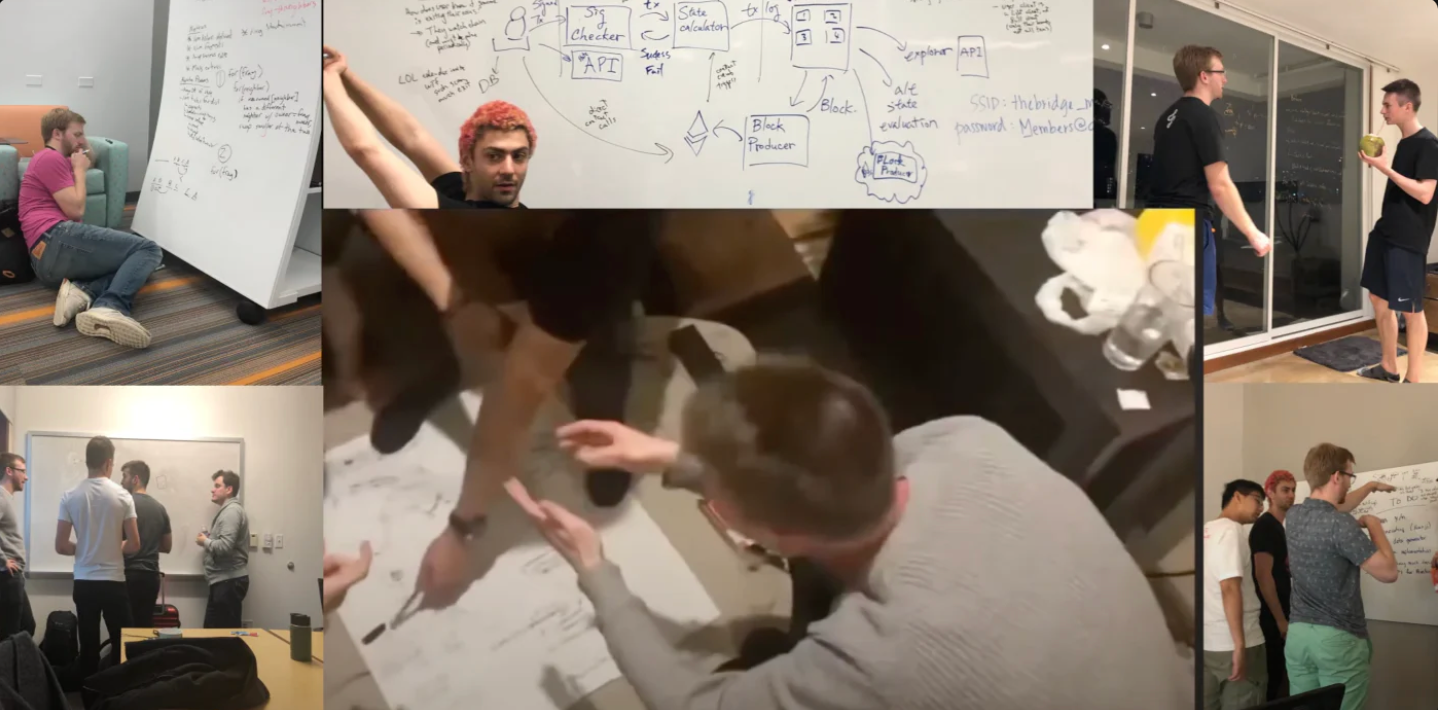
As the team raised significant funding to scale their own operations, they wrote that Optimism was “nearing the end of a chapter and the beginning of the next — one driven by community ownership and governance”. A week later, the news was so hot that even Arbitrum did a quote tweet trying to get in on some of the action:
A New Model of Optimistic Governance
On April 26, 2022, a new model of democratic governance was born. As a decentralized autonomous organization, the Optimism Collective resonates with the soul of Ethereum: the idea that the technology we build and the systems we create to incentivize behavior can create an abundant, sustainable, and techno-optimist future. Calling itself a “new model of digital democratic governance optimized to drive rapid and sustained growth of a decentralized ecosystem”, the governance model is designed to empower a community to build and benefit from a robust public goods funding model.
This model is centered around the axiom of impact=profit and the conviction that funding public goods can be profitable.
The Optimism Collective defines the impact=profit axiom as “…the principle that positive impact to the collective should be rewarded with profit to the individual”. In other words, people and projects should be retroactively funded for contributing to the public good. As Vitalik Buterin writes, “The core principle behind the concept of retroactive public goods funding is simple: it’s easier to agree on what was useful than what will be useful”.
When designing the governance framework, the Optimism team decided to go bicameral, erecting two different governmental bodies to make up the Collective. The Token House, governed through tokenization, will begin to take shape now that Airdrop #1 has occurred. The Citizens’ House will come later and be governed by holders of soulbound NFTs. Each House will be tasked with aligning incentives and values in pursuit of the Optimistic Vision.
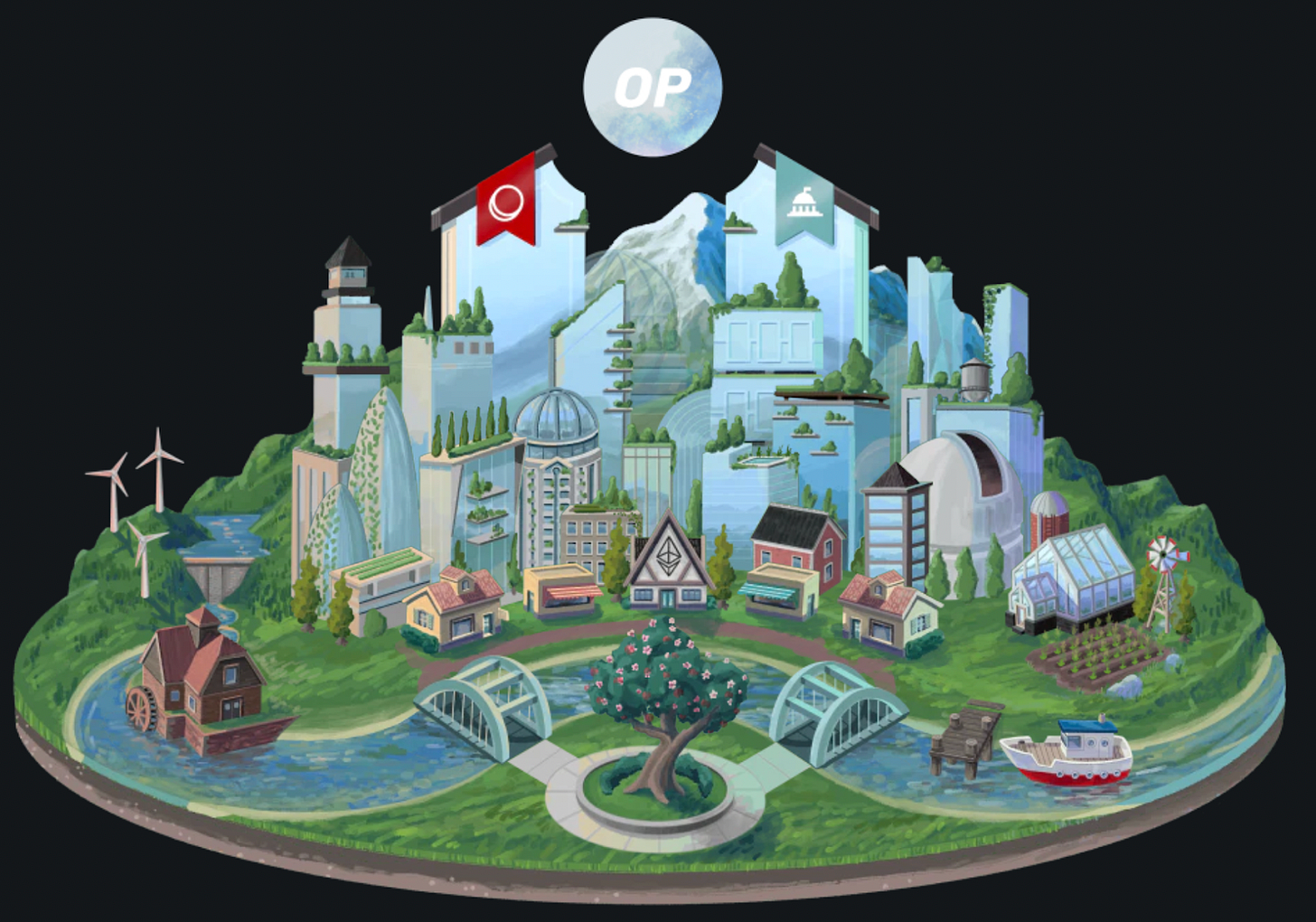
Along with the bicameral structure, the Optimism Foundation was created to help guide the Houses as the community discovers how to govern the Optimism Collective. Initially, the Foundation and the Collective will have to learn how to govern together. As the Collective finds its groove, the Foundation will relinquish its governance responsibilities to the Collective and slowly dissolve in an act of decentralized sacrifice.
The Founding Documents
The founding documents of the Optimism Collective are the Working Constitution of the Optimism Collective and the OPerating Manual v.0.1. The Working Constitution embodies the soul of the Collective and informs its operations. The Manual and all further iterations must stay true to the principles as laid down in the Working Constitution.
Working Constitution
The Working Constitution embodies the spirit of the Collective and creates a flexible framework that supports a sustainable and fair model for democratic governance. It enshrines the Collective’s experimental governance mandate and clearly states that it will self-destruct within four years of adoption as it cedes its authority to the permanent Bedrock Constitution. The Working Constitution also mandates the eventual creation of the Citizens’ House to provide checks and balances to the Token House, and it cements the Foundation’s role in helping to guide the Collective. This Working Constitution is a living document that will continue to evolve as governance successes and failures inform the Collective.
OPerating Manual v0.1
The initial OPerating Manual enacts the principles enshrined in the Working Constitution, providing the operating guidelines and governance procedures for the Token House. The Manual will be updated with the launch of the Citizens’ House. As an experimental and iterative organization, the Collective will ensure the Manual will be regularly revised as the governance model becomes clearer and more refined.
The Optimism Foundation
According to the Working Constitution, the Optimism Foundation is a “Cayman Islands organization responsible for guiding the growth and development of the Optimism Collective”. Upon formation, the Foundation has certain enumerated powers and responsibilities as defined in the Working Constitution. The Foundation will act as the benevolent matriarch, helping to steer the wider Collective of community members, builders, and citizens, until it too decentralizes into Web3’s subatomic optimistic force.
The Collective Blueprints
The Optimism Collective will ultimately be governed by two bodies: the Token House and the Citizens’ House. Although each House will have separate responsibilities and areas of focus, they will share responsibility for granting ‘citizenships’ in the Citizens’ House and defining the network parameters for the Optimism protocol. Until the Citizens’ House is fully formed many of its responsibilities will rest with the Foundation.
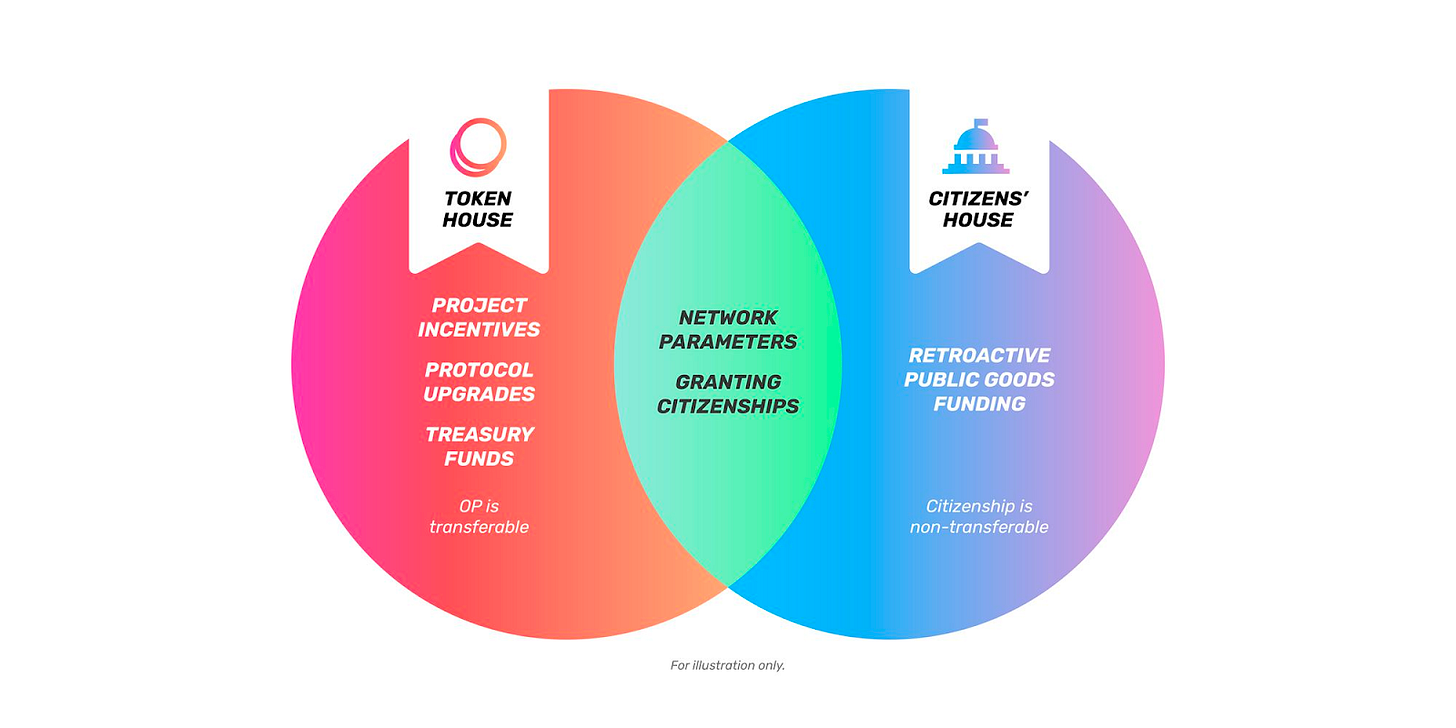
The Token House
The Token House is made up of holders of the OP token, the Optimism Collective’s governance token. OP holders will submit, deliberate, and vote on proposals affecting project incentives, protocol upgrades, disbursement of treasury funds, and network parameters. They also will grant citizenship to the Citizens’ House, once formed. Members may either vote directly or delegate their voting power to a third party.
Governance will be primarily coordinated through the Optimism Forum and Snapshot, the off-chain voting platform. Initially, proposals will be tightly regulated and overseen by the Foundation. Certain proposals, such as those encompassing treasury appropriation or rights protections (changes to the founding documents), may only be initiated by the Foundation. Unlike many protocols, most proposals can be submitted straight to Snapshot for voting.
To minimize voter fatigue and increase participation, voting on proposals will occur at set intervals. Governance proposals must meet quorum (the minimum number of OP votes required for a proposal to be enacted based upon the total OP supply) and overcome an approval threshold, which is the minimum number of votes required to be cast in favor of a proposal. Initial quorum will be set at 10% of the total supply, while approval threshold requirements vary depending on the proposal type.
The Foundation will ensure that only proposals meeting quorum and approval thresholds are considered for implementation. For proposals that meet voting requirements, the Foundation “will determine whether the proposal is safe, secure, consistent with the purposes of the Foundation and the Collective, and capable of being implemented in a legally compliant manner”. If so, the Foundation will work towards proposal implementation; if not, it may be sent back to the Collective for modifications or resubmission, or a proposal may be implemented subject to certain guardrails.
The Citizens’ House
If the Token House is for the plutocrats (Optimism’s term!), then the Citizens’ House is for the people. The primary purpose of the Citizens’ House is to determine how to allocate network revenue and its initial OP token supply to retroactively fund public goods. The Token House is meant to incentivize for the short-term; the Citizens’ House will be built to sustain the Optimism Collective’s long-term vision, anchored in the impact=profit maxim.
In the spirit of optimistic experimentation, membership in the Citizens’ House will be granted via soulbound non-transferable tokens, known as Citizenship NFTs — recipients can’t sell, transfer, or otherwise move these out of their wallet address. Yet soulbound NFTs aren’t without controversy:
That aside, it’s clearly a way to decouple economic incentives from governance, which is a strong check on the Token House. The Citizens’ House, described by Optimism as the identity-first layer of the Collective, will require a new Operating Manual, v0.2, but this experiment in citizen-based governance is expected to commence once the Foundation, in consultation with the Token House, determines the mechanism for granting Citizenship NFTs.
The Token House and Citizens’ House form a marriage of two parties whose incentives do not cleanly map, but who must work together, believe in the vision, and behave optimistically. Optimism doesn’t just bind us when we have the same motivations; it’s a force that steers us towards a collective vision for how we want to live.
OP Token Allocation
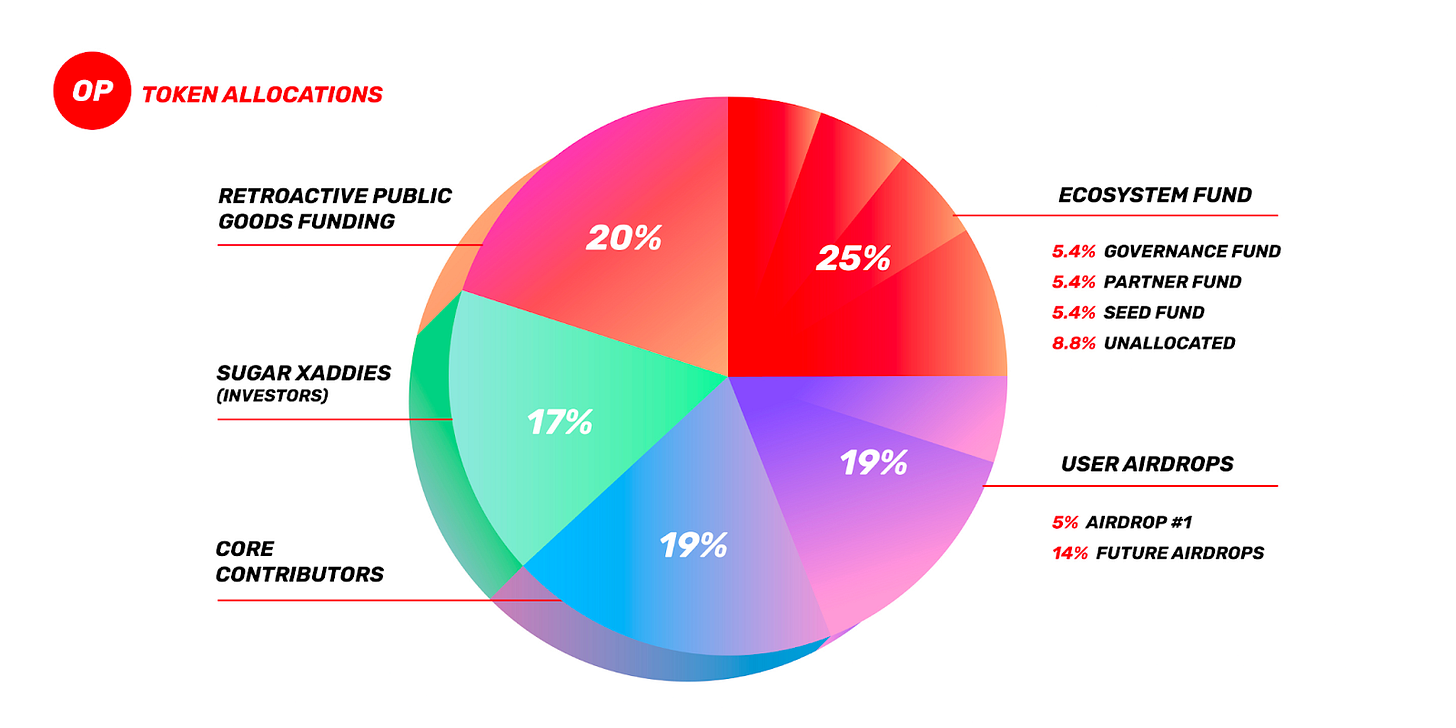
The Token House will be made up of OP holders, and the disbursement method for the tokens has been under discussion throughout the cryptoverse, largely focusing on the mechanics of Airdrop #1. Airdrop #1’s allocation parameters reward active Optimism and Ethereum users who are helping the larger ecosystem grow, but it’s also worth examining the general allocation to get a sense of what Optimism is working to accomplish.
The OP token allocation is broken up into five distinct categories of recipients:
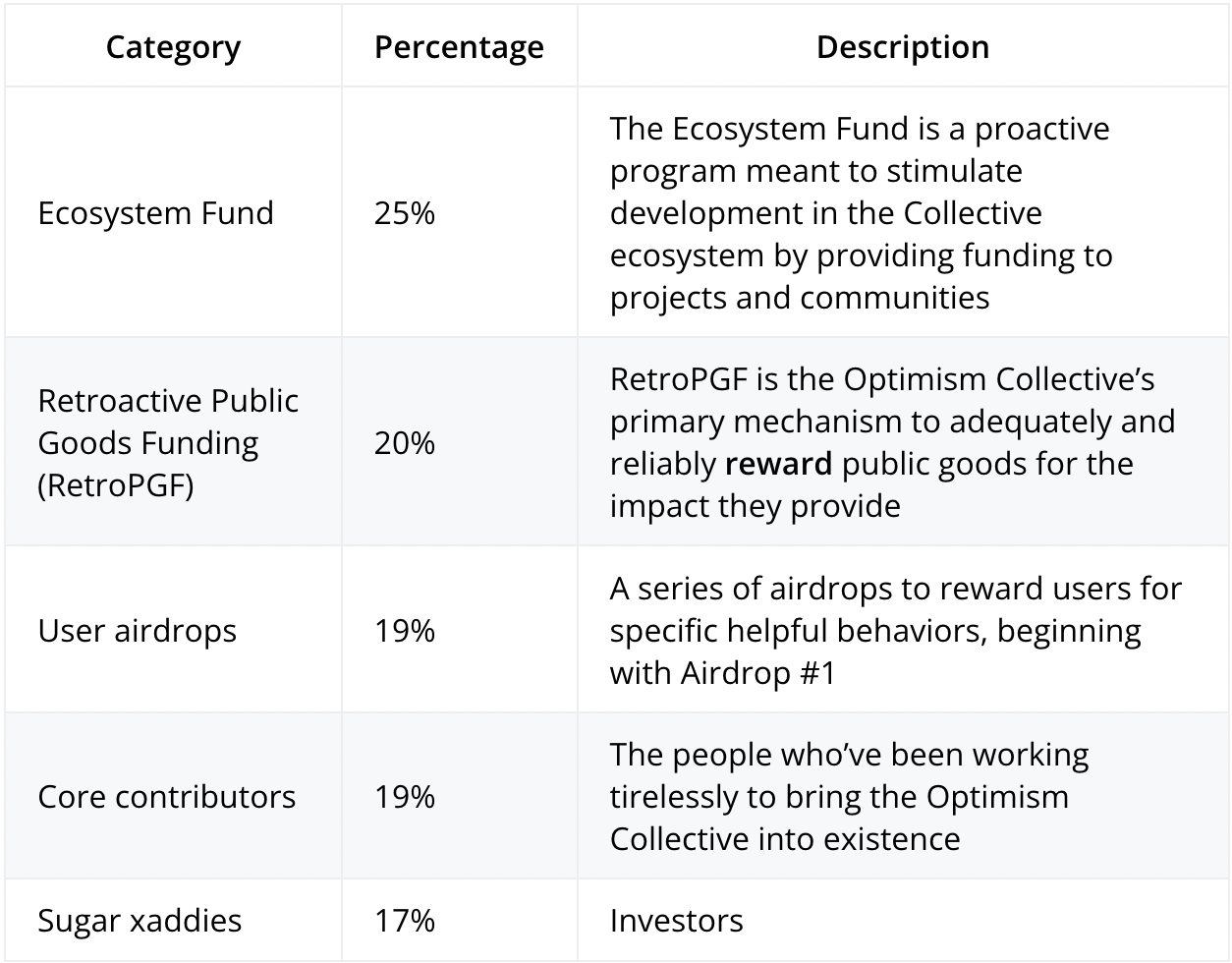
Thirty-six percent of total token supply will be allocated to core contributors and sugar xaddies — those people and entities who have enabled Optimism to reach this point. This type of retroactive allocation is typical in the ecosystem, and recognizes the importance of compensating past work. These allocations will be subject to a lockup period.
At the outset, there will be an initial total supply of just over 4 billion OP tokens, which will inflate at a rate of 2% per year. Sixty-four percent of the total token supply will be allocated to the community of users and projects through airdrops, ecosystem incentives and development, and retroactive public goods funding. A rough approximation of the unlocked OP token supply is below.
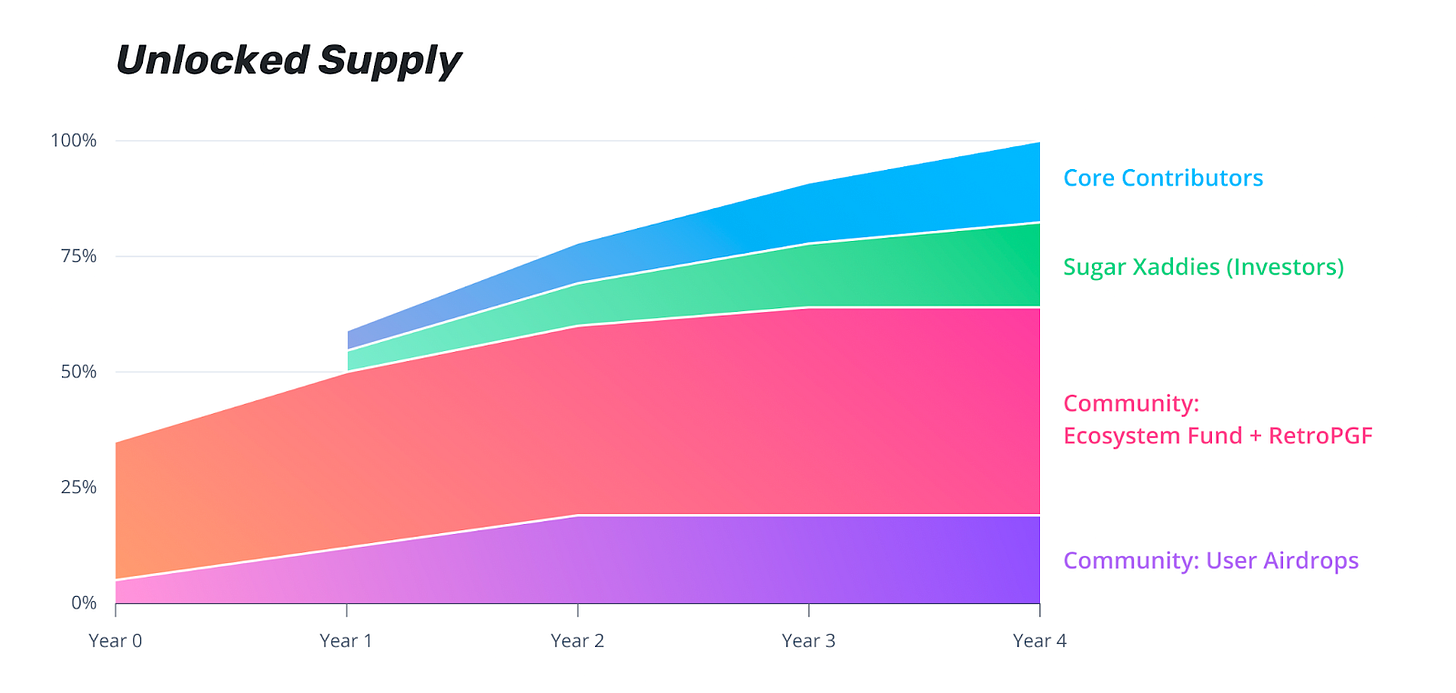
As the graphic makes clear, Optimism expects to release their total token supply over a four-year period, but its main focus will continue to be on proactively funding its ecosystem’s growth and retroactively funding public goods. All of this began with Airdrop #1.
Airdrops
The announcement of Airdrop #1 was a watershed moment for the Ethereum ecosystem as it helped many to understand the core ethos of Ethereum, expounded by Vitalik and scoped by Optimism. Airdrop #1 allocated 5% of the total initial token supply to nearly 250,000 eligible addresses. These users were rewarded for both their use of Optimism and their general support of the Ethereum ecosystem. Ecosystem participants were also allocated OP tokens for voting in DAO-wide Snapshots, being a multisig signer, contributing to Gitcoin Grants on L1, and bridging to other L1s or L2s. Early users of Optimism who met at least four of the six criteria for the airdrop had their allocation boosted.
With an additional 14% allocated to future undefined airdrops, there’s never been a better time to get involved in the Optimism and Ethereum ecosystems. Join a DAO and vote on Snapshot, take on the responsibility that comes with being on a multisig, or donate to Gitcoin Grants to help fund our ecosystem. Or maybe buy a Pooly to support PoolTogether’s efforts to fight back against a malicious lawsuit. We don’t know the parameters of the future airdrops, but likely the best way to get in on future airdrops is to join the Optimism Collective Discord and get involved in shaping the future of protocol governance and public goods funding.
Proactive Ecosystem and Retroactive Public Goods Funding
While rewarding early contributors, investors, and ecosystem participants is important, nothing says public goods like proactive rewards for builders helping to grow the Optimism ecosystem or retroactive funding for goods.
Ecosystem Fund
The Ecosystem Fund is the corollary to the retroactive public goods funding with which we are familiar. Proactive funding seeks to incentivize builders to work within the ecosystem in the future.
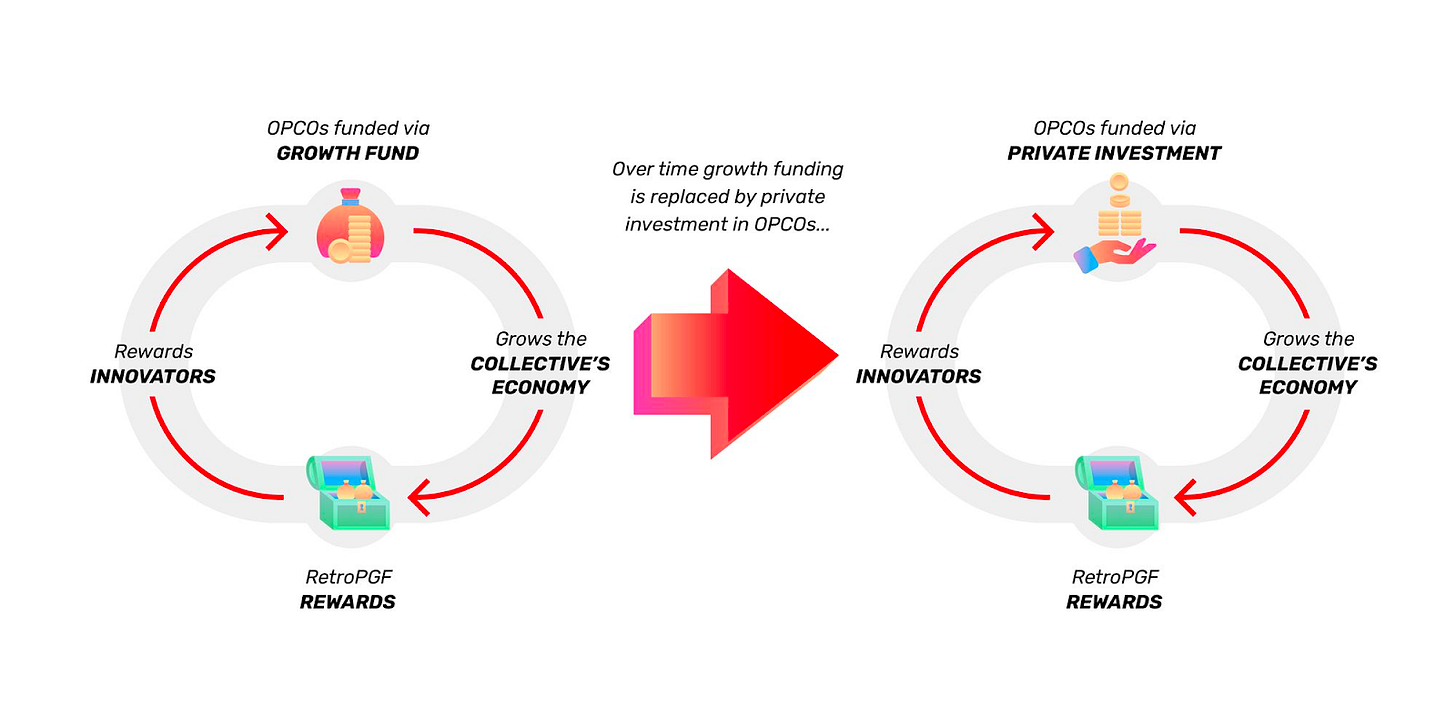
Twenty-five percent of the total token supply will be devoted to building the Optimism Collective ecosystem. This will be split among the Optimism Collective, ecosystem partners as determined by the Foundation, a seed fund for early-stage projects, and future proactive allocations.
The Ecosystem Fund will not get any additional funding following its initial OP token allocation. By the time funds have been spent and support and building are underway, the team is optimistic it can shift the funding to private investors who will be rewarded through the retroactive funding model.
Retroactive Public Goods Funding
Optimism has been retroactively funding public goods for much of its recent history, announcing last July that all revenue generated from block sequencing would be dedicated to such funding. To date, over 1 million USD in retroactive funding has been granted.
In addition to revenue derived from block sequencing, Optimism is allocating 20% of the initial OP token supply to retroactive public goods funding. This retro funding is expected to occur quarterly, with an eye on ensuring that the community and companies that make up the Collective are fairly rewarded based upon their impact.
To understand the full power of the Collective, to truly realize its potential for large-scale impact as a protocol that is also a public goods funding factory, we have to get into protocol economics: the ‘OP’ in ‘Optimism’.
Protocol Economics
Users interacting with the protocol create transaction fees that would fund public goods even without the OP token. But the OP token is the fuel that will ignite the Optimism Collective into a public goods funding powerhouse, building flywheels capable of creating large-scale and lasting change.
Believing that robust public goods enable an abundant ecosystem, the Collective seeks to generate value through a virtuous tokenomics cycle that is elegantly simple:
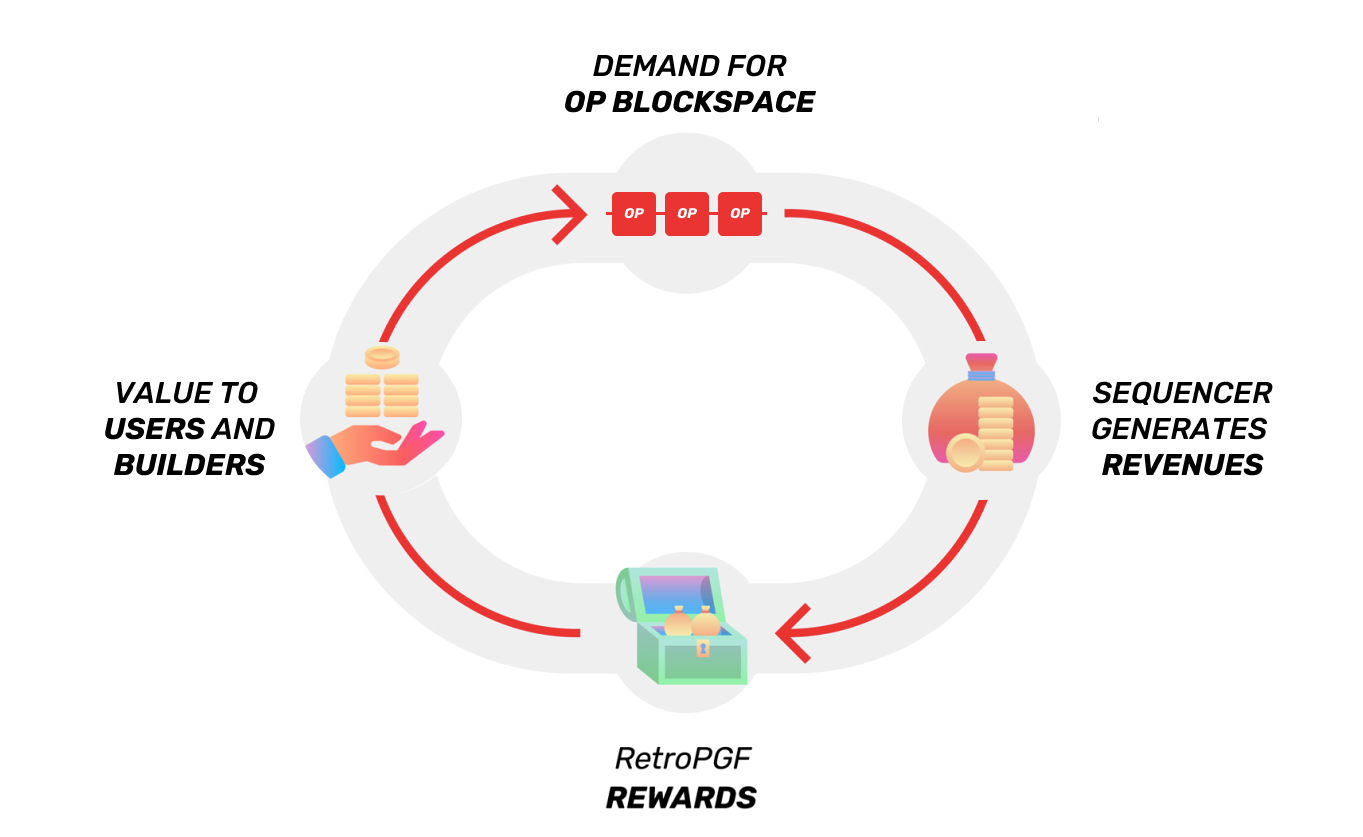
Sequencer fees generated through the protocol are the source of sustainable revenue that will enable OP’s economy to bloom into a flourishing ecosystem. Like our friends at Tally Ho! who are building a community-owned Web3 wallet, the Optimism Collective has hard-wired public goods into its ethos and its product, turning the protocol into a public good.
The first round of retroactive grants for public goods largely focused on tools and infrastructure within the broader Ethereum ecosystem, which will pay dividends for future builders and users. This flywheel of public goods funding is what we get when we incentivize participants to work with new models of social and economic coordination with a focus on building a robust ecosystem.
Collectively Optimistic
We have choices about the way we spend our time in Web3. Determining the methods by which we transact within our ecosystem must align with the overall vision and ethos of how we engage with this wide-open playground. There are many scaling solutions available to help us live a cost-effective life on chain, but there’s only one Optimism Collective.
Powered by the protocol, the Collective is evolving into a fully incentivized community capable of bringing sustainable funding to those who are sowing the early seeds for a rich and vibrant ecosystem. The Collective is tasked with supporting the gardeners tilling the soil, providing it with nutrients, and tending to the shoots as they slowly grow and spread into a lush, interdependent canopy.
Now is a great time to become more OPtimistic. Check to see if you can claim some OP tokens. Get involved in their Discord, apply for a job at the Optimism Foundation, or just follow them on Twitter and help spread the word. Claim or swap for OP tokens and get active in Token House governance or work to become a member of the Citizens’ House.
We have the choice to support protocols that are building innovative governance structures to serve the greater good. It’s easy to get lost in the cryptoverse, but the Collective’s guiding light gives us good reason to be more optimistic not just about crypto, but about our collective future.
A version of this article was first released in BanklessDAO’s State of the DAOs newsletter on June 1, 2022.
Author Bio
Hiro Kennelly is a writer and shipper at Bankless Publishing, building at BanklessDAO, an Associate at Bankless Consulting, and is now and forever a DAOpunk.
BanklessDAO is an education and media engine dedicated to helping individuals achieve financial independence.
Bankless Publishing is always accepting submissions for publication. We’d love to read your work, so please submit your article here!
This post does not contain financial advice, only educational information. By reading this article, you agree and affirm the above, as well as that you are not being solicited to make a financial decision, and that you in no way are receiving any fiduciary projection, promise, or tacit inference of your ability to achieve financial gains.